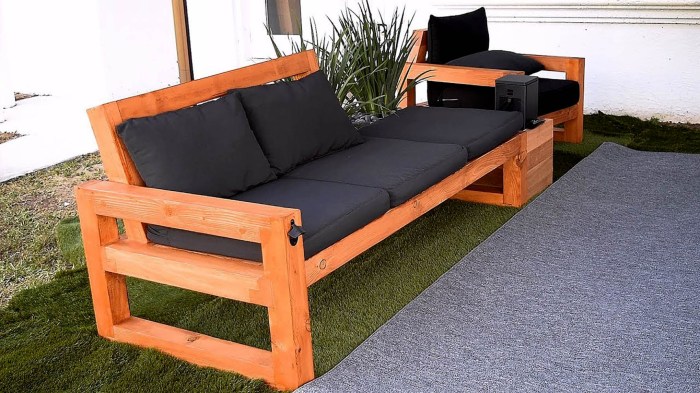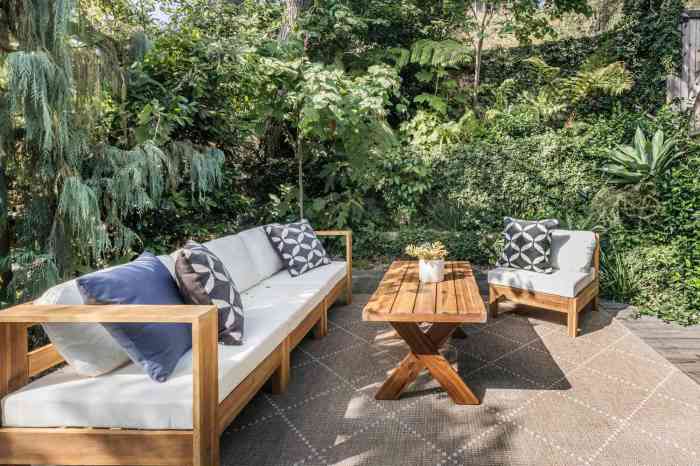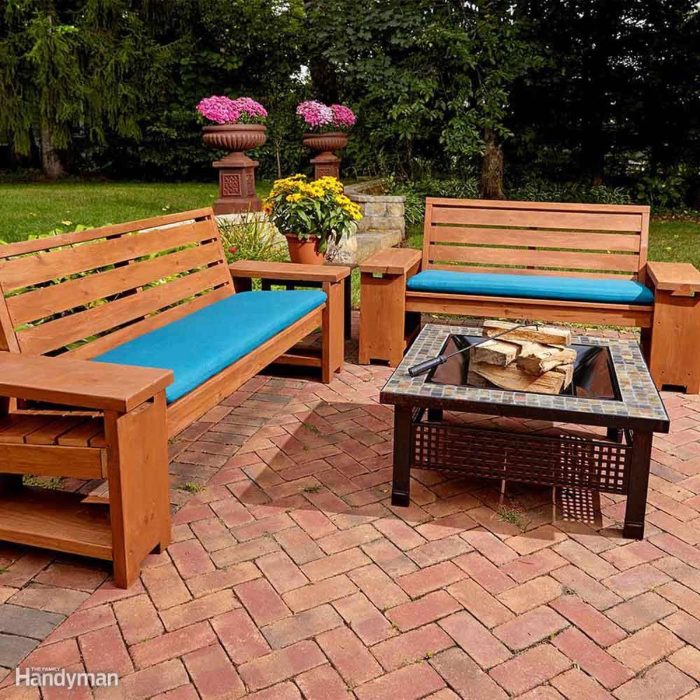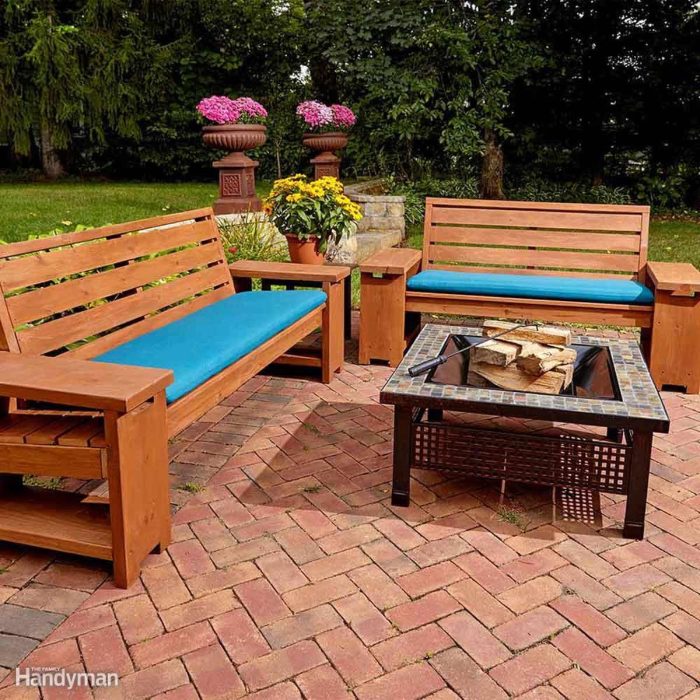DIY patio furniture plans offer a fantastic way to transform your outdoor space into a personalized haven. Whether you’re a seasoned craftsman or a novice woodworker, there’s a project out there for you. From simple chairs to elaborate swings, these plans guide you through every step of the process, empowering you to create custom pieces that reflect your style and budget.
The beauty of DIY patio furniture lies in its versatility. You can choose from a wide array of materials, including wood, metal, and even recycled items. This allows you to create furniture that complements your existing décor and blends seamlessly with your outdoor environment. The satisfaction of building something with your own hands is unmatched, and the finished product becomes a testament to your creativity and skill.
Essential Tools and Materials for DIY Patio Furniture: Diy Patio Furniture Plans
Creating your own patio furniture can be a rewarding and cost-effective project. Before you begin, it’s essential to have the right tools and materials on hand. This will ensure a smooth and successful building process.
Essential Tools
Having the right tools is crucial for building patio furniture. You’ll need a combination of power tools, hand tools, and safety equipment.
- Power Tools: Power tools can significantly speed up the building process. Here are some essential power tools:
- Circular Saw: For making precise cuts in wood.
- Drill/Driver: For drilling holes and driving screws.
- Sanding Tools: A sander, either orbital or belt, is essential for smoothing surfaces and creating a professional finish.
- Miter Saw: A miter saw allows you to make precise angled cuts, essential for creating joints and frames.
- Router: A router is used for creating decorative edges, grooves, and other intricate details.
- Hand Tools: Hand tools are essential for various tasks, including measuring, marking, and assembling.
- Measuring Tape: For accurate measurements.
- Level: For ensuring that your furniture is level and stable.
- Hammer: For driving nails and securing pieces.
- Screwdriver Set: For driving screws and assembling pieces.
- Clamps: For holding pieces together while you work.
- Chisel: For shaping and carving wood.
- Safety Equipment: Safety should always be a priority when working with tools.
- Safety Glasses: Protect your eyes from flying debris.
- Ear Protection: Protect your hearing from loud noises.
- Work Gloves: Protect your hands from splinters and injuries.
- Dust Mask: Protect your lungs from sawdust and other particles.
Common Materials
The choice of materials for your patio furniture depends on your desired style, budget, and durability requirements. Here are some common materials used:
- Wood: Wood is a popular choice for patio furniture due to its natural beauty, versatility, and affordability.
- Cedar: Known for its natural resistance to rot and insects, making it ideal for outdoor furniture.
- Teak: A durable and weather-resistant hardwood that ages beautifully.
- Pine: A softwood that is easy to work with but may require more maintenance.
- Ipe: An extremely hard and durable hardwood that is resistant to rot, insects, and weathering.
- Metal: Metal offers durability, longevity, and a modern aesthetic.
- Aluminum: Lightweight, rust-resistant, and easy to work with.
- Steel: Strong and durable but can rust if not properly treated.
- Wrought Iron: Adds a classic and elegant touch but requires regular maintenance.
- Plastic: Plastic is a budget-friendly option that is lightweight and easy to clean.
- Polypropylene: A durable and weather-resistant plastic often used for outdoor furniture.
- Polyethylene: A flexible and lightweight plastic that is often used for chairs and tables.
Importance of Choosing High-Quality Materials
Choosing high-quality materials is crucial for the durability and longevity of your patio furniture.
“Investing in high-quality materials will pay off in the long run, as your furniture will be able to withstand the elements and last for years to come.”
- Durability: High-quality materials are designed to withstand the rigors of outdoor use, including sun, rain, and temperature fluctuations.
- Longevity: Durable materials will resist wear and tear, ensuring that your furniture remains in good condition for years to come.
- Maintenance: Some materials, like teak and cedar, require minimal maintenance, while others, like wrought iron, may require regular cleaning and treatment to prevent rust.
Finishing Touches for Your DIY Patio Furniture

Now that you’ve built your patio furniture, it’s time to give it that extra touch of personality and protection. This is where finishing techniques come in, allowing you to enhance the look and durability of your creations. Whether you’re aiming for a natural wood finish, a vibrant splash of color, or a weather-resistant shield, the right finishing touches can make all the difference.
Choosing the Right Finish
Selecting the right finish for your DIY patio furniture is crucial, as it will impact its appearance, durability, and overall lifespan. Consider the material of your furniture, the desired aesthetic, and the level of protection you need.
- Paint: For a bold and vibrant look, paint is a great option. It offers a wide range of colors and finishes, from matte to glossy. Consider using exterior-grade paint for added durability and weather resistance.
- Stain: To showcase the natural beauty of wood while adding a layer of protection, stain is a popular choice. It penetrates the wood, enhancing its grain and color. Choose a stain formulated for outdoor use to resist fading and water damage.
- Sealant: Sealants are designed to protect your furniture from the elements, including water, UV rays, and dirt. They come in various finishes, from matte to glossy, and can be applied over paint or stain. For maximum protection, consider using a sealant specifically designed for outdoor furniture.
Adding Decorative Elements
Once your furniture is finished, it’s time to add some decorative elements to personalize it and make it truly your own.
- Cushions and Pillows: Cushions and pillows add comfort and style to your patio furniture. Choose colors and patterns that complement your furniture and outdoor decor. Consider using weather-resistant fabrics for outdoor use.
- Plants: Plants can add a touch of life and color to your patio. Choose plants that thrive in your climate and can tolerate the sun and shade conditions of your patio. Consider using hanging planters, pots, or trellises to display your plants.
- Throws and Blankets: For added warmth and style, consider adding throws and blankets to your patio furniture. Choose fabrics that are comfortable and weather-resistant.
DIY Patio Furniture Design Ideas

Bring your outdoor space to life with unique and personalized DIY patio furniture. You can create a relaxing retreat that reflects your style and enhances your home’s curb appeal. With a little creativity and these design ideas, you can build pieces that are both functional and visually appealing.
Contemporary Designs
Contemporary patio furniture often features clean lines, geometric shapes, and a minimalist aesthetic. This style is characterized by its simplicity and functionality.
- Sleek Loungers: Consider building a low-slung lounger with a wide, inviting seat and a minimalist frame. Use materials like teak or aluminum for a modern look.
- Modular Seating: Modular seating systems allow you to create different configurations to suit your needs. Build individual modules with square or rectangular cushions and a simple metal frame.
- Geometric Tables: A geometric coffee table with a sleek, minimalist design can add a touch of sophistication to your patio. Use materials like concrete or metal for a contemporary feel.
Rustic Designs, Diy patio furniture plans
Rustic patio furniture embraces natural materials and textures, creating a warm and inviting atmosphere. This style often features distressed wood, reclaimed materials, and earthy tones.
- Reclaimed Wood Benches: Use reclaimed wood to build a sturdy and rustic bench for your patio. You can leave the wood natural or add a layer of stain or paint for a more polished look.
- Log Coffee Tables: A log coffee table adds a touch of rustic charm to your outdoor space. Choose a large, sturdy log and create a simple base for it.
- Wicker Chairs: Wicker chairs are a classic choice for rustic patio furniture. You can find wicker chairs in a variety of styles and sizes, from traditional to contemporary.
Minimalist Designs
Minimalist patio furniture focuses on simplicity and functionality. This style is characterized by clean lines, neutral colors, and a lack of unnecessary ornamentation.
- Simple Chairs: Build a set of minimalist chairs with a simple frame and comfortable cushions. Use materials like metal or wood for a clean and modern look.
- Floating Shelves: Floating shelves can be used to display plants, books, or other decorative items. Choose a minimalist design with a simple metal or wood frame.
- Hanging Planters: Hanging planters add a touch of greenery to your patio while keeping your space clutter-free. Choose minimalist planters in simple shapes and neutral colors.
DIY Patio Furniture Projects for Different Skill Levels

Creating your own patio furniture can be a rewarding experience, allowing you to personalize your outdoor space and save money. But before you dive in, it’s essential to choose a project that matches your skill level. This ensures a smooth and enjoyable experience, leading to a piece you’ll cherish for years to come.
Beginner Projects
Beginner projects are ideal for those new to woodworking or DIY. These projects are relatively simple, requiring minimal tools and materials.
- Pallet Planter Boxes: This project requires minimal woodworking skills. Simply repurpose old pallets into attractive planter boxes for your favorite flowers or herbs. You’ll need a saw, drill, and screws.
- Simple Adirondack Chairs: This classic patio chair is a great beginner project. While it may seem complex, it involves straightforward cuts and assembly. You’ll need a saw, drill, and screws.
- Cinder Block Coffee Table: Transform cinder blocks into a unique and functional coffee table. You’ll need cinder blocks, plywood, paint, and a few basic tools.
Intermediate Projects
Intermediate projects require a bit more experience and involve more complex techniques. You’ll need a wider range of tools and materials.
- Outdoor Bench with Storage: Build a sturdy bench with a built-in storage compartment for extra cushions or outdoor tools. This project requires some basic woodworking skills, including cutting angles and using joinery techniques.
- DIY Patio Swing: Create a relaxing swing for your patio. This project involves constructing a sturdy frame and attaching a comfortable swing seat. You’ll need basic woodworking skills, including cutting curves and using hardware like hinges.
- Trellis Planter: Combine function and beauty with a trellis planter. This project requires creating a sturdy trellis structure and incorporating planters for climbing plants. You’ll need woodworking skills, including cutting angles and using joinery techniques.
Advanced Projects
Advanced projects require significant woodworking experience and a strong understanding of joinery techniques. These projects often involve intricate designs and require specialized tools.
- Outdoor Dining Table: Create a statement piece for your patio with a custom-built dining table. This project involves precise cuts, complex joinery, and possibly using a router.
- Modular Patio Furniture Set: Design and build a cohesive set of patio furniture, including chairs, a sofa, and a coffee table. This project requires advanced woodworking skills, including creating custom shapes and using specialized joinery techniques.
- Pergola with Built-in Seating: Build a stunning pergola with integrated seating. This project requires advanced woodworking skills, including framing, roofing, and creating custom seating.
Building your own patio furniture is a rewarding experience that combines creativity, practicality, and a touch of DIY magic. By following the right plans and utilizing high-quality materials, you can create durable and stylish pieces that will enhance your outdoor living space for years to come. So, gather your tools, unleash your inner craftsman, and embark on a journey to create a patio oasis that truly reflects your personal style.
Creating DIY patio furniture plans is a rewarding project, allowing you to personalize your outdoor space. While you’re building your furniture, consider adding a touch of green with an indoor hydroponic garden diy to bring a fresh, vibrant element to your patio. The hydroponic garden can provide a sustainable and visually appealing addition to your outdoor space, complementing your DIY furniture perfectly.

